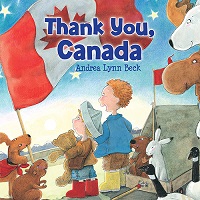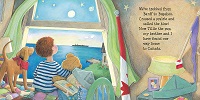| ________________
CM . . . . Volume XXIV Number 14. . . . December 8, 2017
Rhyming books with themes are always a challenge. Can the author find the right rhymes without creating awkward phrases? Does the author keep the reader interested in the content?
The text struggles right from the beginning:
There are at least two places called Bugaboo - one in California and one in South Korea. Which location are they coming from? The children have found their “way home to Canada.” “Home” would presumably be Banff, but the artwork shows the children looking out of a bedroom window onto the sea. Where are they? Beck also mentions her pup, Tillie, in the first verse, but the dog’s role in the story ends at that point, although it continues to appear in the drawings. Young children would be happy to have the story continue to mention the dog. It makes no sense not to. The next page has a verse that repeats what has been said on the first page:
The children are looking out in the distance, but who they are addressing in the first line is not indicated there or later in the story. Why are the children in a forest ranger station, and why does Beck draw other similar stations (all topped with Canadian flags) without explaining what they mean in relation to the Canadian landscape? The painting below the ranger station is green, but trees are not clearly drawn in. And how to explain verses combining unrelated places, activities, objects and a variety of miscellany?
and:
It’s up to the parent or teacher to imagine the logic of being thankful for shopping malls and why dollar coin currency is better than paper bills(?). Will most adults know much about Stanley Park? Beck does give a nod to having two official languages plus many more, and she references the armed forces “so brave and strong and true.” The children in the illustration on that page are wearing poppies as they stand in front of a large maple leaf flag, the shadows of armed personnel woven in. But ultimately, it’s not clear why Beck thinks children should be thankful for Canada. A melange of Canadian stereotypes - geese, beavers, great big spruce (not shown) do not deliver the message Beck would likely want children to absorb. Her illustrations will engage children who will learn about some Canadian symbols by looking at the pictures. Recommended with Reservations. Harriet Zaidman enjoyed her 25 years as a teacher-librarian in Winnipeg, MB.
Next Review |
Table of Contents for This Issue
- December 8, 2017. |

 Andrea Lynn Beck does not quite achieve these goals in the text of her latest book, Thank You, Canada, although her endearing and skillfully drawn pencil and watercolour artwork will appeal to children in the target age group. This title is the third in a series, following
Andrea Lynn Beck does not quite achieve these goals in the text of her latest book, Thank You, Canada, although her endearing and skillfully drawn pencil and watercolour artwork will appeal to children in the target age group. This title is the third in a series, following  Beck’s theme is gratitude, but her search for rhyming words outweighs her ability to create a plot that flows, a consistent story that builds and comes to a satisfying conclusion.
Beck’s theme is gratitude, but her search for rhyming words outweighs her ability to create a plot that flows, a consistent story that builds and comes to a satisfying conclusion.